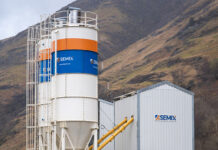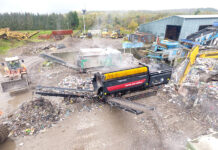David Kinloch, business development executive at CDE Global, discusses new ways to approach construction waste and recycling restrictions
COUNCILS all over the UK are becoming stricter when it comes to issuing new mineral extraction licences as they try to manage and preserve their own natural resources.
In Scotland we are already seeing businesses reacting to an impending increase in the number of restrictions and taking the necessary steps to prepare for the future changes within the industry.
At CDE we are anticipating that there will be an increase in the need for the recycling of construction and demolition waste in the coming years. In Great Britain the percentage of the aggregate market which came from recycled aggregate sources has moved from 10% in 1990 to 28% at the end of 2015. That shows that the use of recycled aggregates is becoming increasingly accepted within the GB construction market.
LANDFILL TAX
As it stands, in order for inert construction, demolition and excavation waste in Scotland to go to landfill, it is subject to a £2.65 per tonne landfill tax along with any gate or tipping fees the landfill operator applies.
This material, however, can be diverted from landfill and recycled into useful aggregates. By doing this businesses are not only saving money on landfill tax but they are also easing the burden on Scotland’s natural aggregate resources and prolonging vital resources.
The material and sand produced will avoid the £2 per tonne aggregate levy that all natural aggregates are subject to. This means the recycler has a £2 per tonne advantage straight away over competitors selling natural aggregates.
Recycling facilities can be set up in urban environments such as industrial estates in the city or on motorway networks to give a logistical advantage over natural aggregate suppliers, meaning there is much greater flexibility on where to set up operations. A quarry extracting natural aggregates is confined to where the material resource is.
When trucks come to tip off waste for recycling they can also lift clean aggregate to take back to the site they are working on, reducing transport costs on a low cost and high volume product.

RECYCLING METHODS
There are two main methods of recycling in use at the moment. Dry crushing and screening is generally used on materials such as crushed concrete.
Operators have to be very particular on what they bring in as wet, sticky, clay bound materials cannot be processed. As a result this method can be weather dependent and in wet weather it may not be possible to operate.
The final aggregate product this method produces is generally a lower value all in sub base or capping product.
Wet processing, the type that CDE works with companies around the world on, can operate all year round and the operator does not need to be particular on what they take.
For example the material can be wet, sticky, clay bound, concrete, excavation waste, construction and demolition waste or soils. The final product from wet processing is high value as it allows the company to produce clean single size aggregates and sands which are in specification to be used in concrete. The aggregates and sands are sold back into the construction market to be used on new developments.
The ferrous metals are recycled and the silt and clay cake is used for landfill capping.
LEADING THE WAY
Thompson Recycling from Dumbarton outside Glasgow is just one company looking ahead to a future of sustainable construction. They have installed a wet processing recycling plant and since then they have had planning passed to excavate their existing inert landfill and process the material through their recycling wash plant.
They are the first and only company in Scotland to be excavating an inert landfill to recycle it. By doing this they intend to extend the life of the landfill by 30 years. It also means that what used to be a landfill for Thompson Recycling is now acting as a large stockpile of material for them to feed into their wash plant and produce quality aggregates which they can then sell back into the construction market as a direct replacement for natural aggregate.
This industry is moving forwards, becoming more innovative and sustainable.
It is time for all construction businesses in Scotland to look strategically at the future of their businesses before their activities become hampered by new restrictions.













